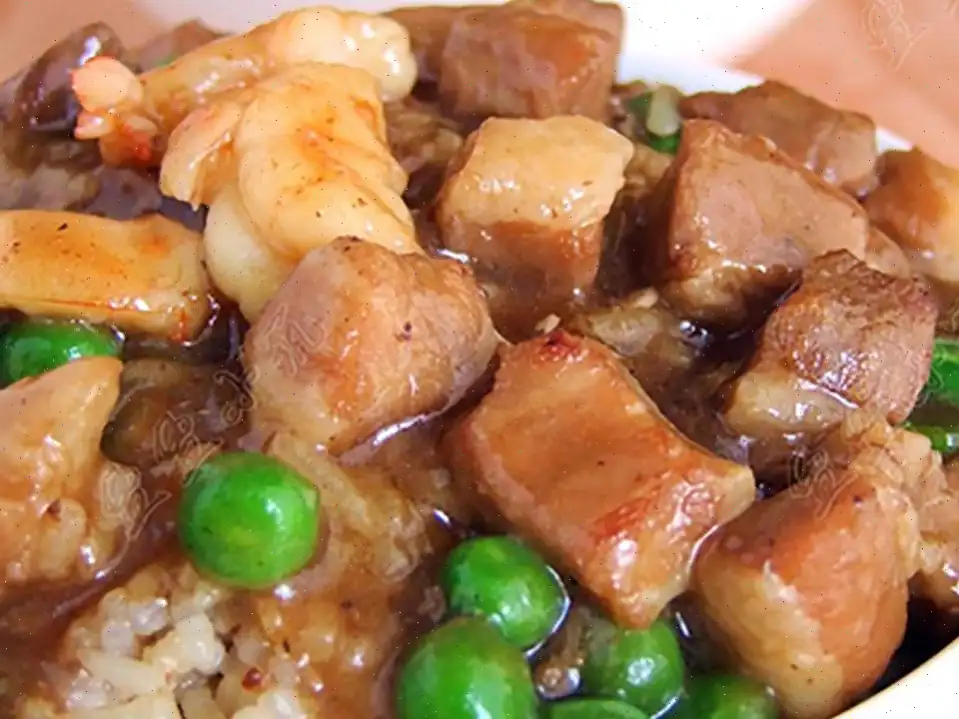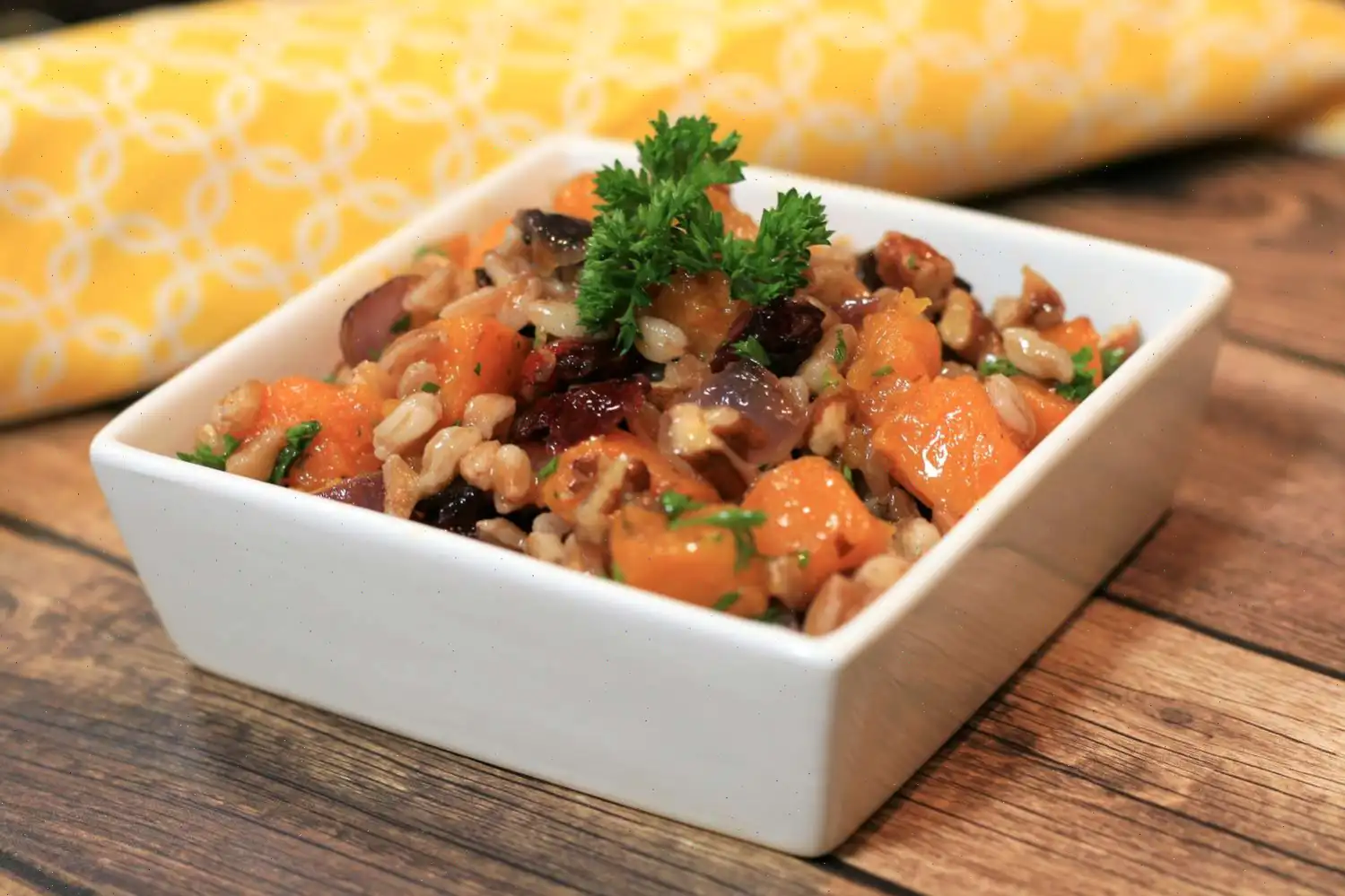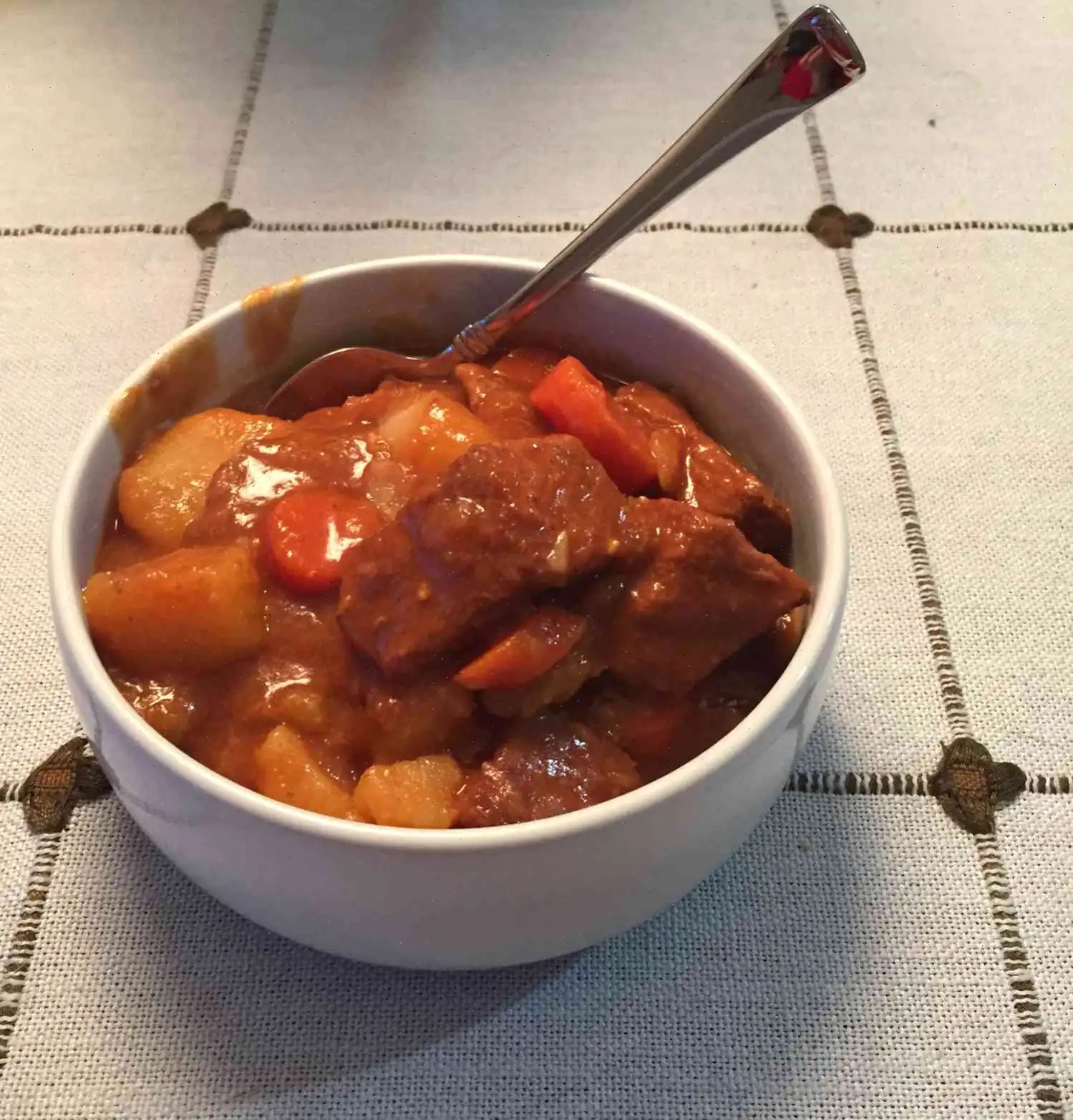
Filipino Steamed Rice, Cebu Style Recipe
Ingredients
This recipe was developed at its original yield. Ingredient amounts are automatically adjusted, but cooking times and steps remain unchanged. Note that not all recipes scale perfectly. Original recipe (1X) yields 4 servings.
For the Pork:
- 1 pound pork belly, cut into 3/4-inch cubes
For Marinade:
- 2 teaspoons Chinese cooking wine
- 1 teaspoon oyster sauce
- 1 teaspoon cornstarch
- teaspoon sesame oil
- teaspoon salt
- 1 pinch ground black pepper
For Pork and Shrimp Stew:
- 1 teaspoon vegetable oil
- 1 tablespoon minced garlic
- tablespoon fried shallots (Optional)
- 3 cups water
- 1 tablespoon light soy sauce, or to taste
- teaspoon dark soy sauce
- pound uncooked medium shrimp, peeled and deveined
- 1 tablespoon cornstarch
- 3 tablespoons water
- 2 tablespoons frozen peas
For Garlic Fried Rice:
- 2 tablespoons vegetable oil
- 2 tablespoons minced garlic
- 2 cups cooked jasmine rice, cooled, or more to taste
- 1 teaspoon light soy sauce
- 3 drops sesame oil, or to taste
Directions
Step 1: Mix the pork belly with Chinese cooking wine, oyster sauce, cornstarch, sesame oil, salt, and black pepper in a bowl. Marinate in the refrigerator for at least 20 minutes.
Step 2: Heat vegetable oil in a pot over medium-high heat. Add minced garlic and fried shallots (if using). Cook and stir until fragrant, about 1 minute.
Step 3: Add the marinated pork belly pieces and fry until browned, about 6 minutes.
Step 4: Pour in water, light soy sauce, and dark soy sauce. Cover the pot and bring the stew to a boil. Reduce the heat to medium and cook for about 30 minutes, until the pork becomes tender and the water has reduced by half.
Step 5: Cut the shrimp into 3/4-inch pieces. In a separate bowl, mix cornstarch with 3 tablespoons of water.
Step 6: Bring the stew to a boil again, then add the shrimp and peas. Cook for about 2 minutes, or until the shrimp changes color.
Step 7: Quickly stir in the cornstarch mixture. Cook and stir for 7 to 10 minutes, until the gravy thickens.
Step 8: For the fried rice, heat oil in a wok over medium-high heat. Add minced garlic and saut until fragrant, about 1 minute.
Step 9: Increase the heat to high and add the cooked rice. Break up the rice with a spatula and cook for 3 to 5 minutes until loosened.
Step 10: Add light soy sauce and cook for an additional 3 minutes, stirring until the rice is fluffy and heated through. Drizzle with sesame oil to taste.
Step 11: Divide the garlic fried rice between 3 or 4 bowls, and top with the pork and shrimp stew.
Recipe Tips
- Use any cut of pork you like, preferably something with both lean meat and some fat, such as collar butt.
- White pepper powder can be used in place of black pepper, and you can substitute a pinch of sugar for the dark soy sauce.
- It's important not to over-season the rice, as you dont want the rice flavor to overpower the stew. Over-seasoning may also make the dish too salty.
Nutrition Facts
Per serving: 466 Calories
| Nutrition Information | Amount per serving |
|---|---|
| Total Fat | 26g |
| Saturated Fat | 7g |
| Cholesterol | 84mg |
| Sodium | 1312mg |
| Total Carbohydrate | 34g |
| Dietary Fiber | 1g |
| Total Sugars | 0g |
| Protein | 22g |
| Vitamin C | 3mg |
| Calcium | 34mg |
| Iron | 3mg |
| Potassium | 322mg |
* Percent Daily Values are based on a 2,000 calorie diet. Your daily values may be higher or lower depending on your calorie needs.
** Nutrient information is not available for all ingredients. Amount is based on available nutrient data.

The Filipino Steamed Rice, Cebu Style is a delightful Filipino dish that combines the flavors of tender pork belly, succulent shrimp, and fragrant garlic fried rice. This dish is a staple in Cebu, a province in the central Philippines, and is often enjoyed during family meals, gatherings, or celebrations. The dish's savory stew, made from pork and shrimp, sits on a bed of fluffy rice, creating a mouth-watering balance of flavors. The addition of fried shallots and sesame oil enhances its aroma, making it an irresistible meal for anyone who tries it.
History and Origin
Originating from Cebu City, Filipino Steamed Rice, Cebu Style (also known locally as "Puto Maya") has deep roots in the regional culinary traditions of the Visayas. Cebu is renowned for its rich food culture, where dishes often combine the freshest ingredients with Asian influences brought by centuries of trade and migration. Filipino Steamed Rice, Cebu Style, is an excellent example of how the Filipinos have adapted global flavors, including Chinese-style cooking, to create something uniquely Filipino. The dish has become so beloved that it is often associated with family gatherings and festive occasions, where it is prepared in large quantities to be shared with loved ones.
Regional Variations
Cebu is not only famous for its delicious lechon (roast pig) but also for its distinctive take on dishes like this one. Cebuano cuisine typically leans towards savory and hearty meals that highlight fresh, local ingredients like pork, shrimp, and rice. Unlike the more common Filipino fried rice dishes found in other parts of the Philippines, Cebu's version of steamed rice features a stew that combines tender pork and shrimp, making it unique. Additionally, Cebuano-style rice is often paired with sinamak (spiced vinegar) or other local dipping sauces, which bring an added layer of flavor to the meal.
How It Differs from Similar Dishes
While other Filipino dishes such as sinangag (garlic fried rice) and lechon kawali (crispy pork belly) may appear similar, Filipino Steamed Rice, Cebu Style, stands out because of its distinctive stew. The addition of shrimp in the stew makes it different from standard pork or beef-based fried rice dishes. Another key difference is the way the pork is marinated and cooked in the stew, which creates a more flavorful and tender meat. In contrast to the regular stir-fried rice, the Cebuano version places emphasis on layering the rich stew over the rice, making for a more balanced and complex dish.
Where It's Served
This dish is most commonly served in the province of Cebu, especially in family-owned restaurants, local eateries, or during Filipino celebrations such as birthdays and festivals. It's a popular choice for dinner or lunch, often accompanied by a variety of side dishes such as pickled vegetables or sinigang (sour soup). In urban areas like Cebu City, its often enjoyed at food stalls or mall vendors that specialize in traditional Filipino meals. Its comforting nature and rich flavors make it a perfect choice for sharing among family and friends.
Interesting Facts
1. Cebu is often referred to as the "Queen City of the South" in the Philippines, and it is famous not only for its beautiful beaches but also for its dynamic culinary scene. Filipino Steamed Rice, Cebu Style, reflects the citys commitment to flavor and tradition.
2. Pork belly is a key ingredient in many Filipino dishes, especially in the Visayan region, where it is celebrated for its tenderness and rich flavor.
3. The use of shrimp in this dish adds a touch of seafood that complements the savory pork stew, creating a unique fusion of land and sea flavors.
4. While the dish may seem simple, it requires careful marination of the pork and a precise balance of seasoning to ensure that each bite delivers the perfect mix of flavors.
Conclusion
Filipino Steamed Rice, Cebu Style, is more than just a meal; it is a testament to Cebus vibrant culinary heritage. With its savory pork and shrimp stew paired with aromatic garlic fried rice, this dish provides a perfect snapshot of Cebuano cuisine's depth and richness. Whether you're exploring the regions local flavors or preparing it at home, this dish is sure to bring a taste of Cebu's heartwarming traditions to your table.








